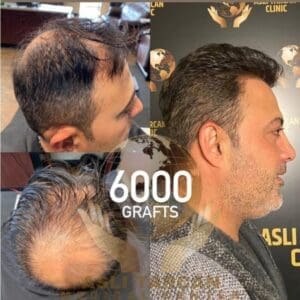Everyone experiencing male pattern baldness welcomed the medical advances that led to modern procedures for hair restoration. Thanks to the latest tools and techniques, hair transplant surgeons can now offer incredibly natural-looking results with a success rate of up to 98% and minimal scarring, but one big question is still on people’s minds: “How long will it last?”
The answer to this question is nuanced. We will provide some estimates, but also go into more detail about the various factors that can affect the outcome and the longevity of donor hair, and what you can do to maintain a full head of hair for as long as possible.
How Long Can a Good Hair Transplant Last?
As each patient has a different genetic profile, a specific rate of hair loss, and their own unique lifestyle, with many outside factors that can have an influence, it’s impossible to give a generic answer. For some, it can last for 10 or 15 years before the hair starts thinning out again, while others may be happy with the results for the rest of their lives.
Certain people can continue to experience rapid hair loss in adjacent areas within a few years after the procedure, or even damage the follicles before they have fully healed and strengthened. All of this can drastically shift the expected timeline, so it will be different for each patient.
However, we can say that by choosing a reputable clinic, following the proper aftercare procedures, and being a little bit more careful not to pull your hair or damage it in your daily life, you can expect to have a beautiful and youthful look for years.
Will the Method Used Affect the Duration of Hair Transplant Results?
Generally speaking, the methods used will only influence how long it takes to heal post-op and what the final result will look like. Doctors consider hair transplant permanent, so the follicles will remain intact, but they may start to produce fewer or thinner and shorter strands with time. That part is related to your genetics.
The main difference is that the older hair transplant procedure, called Follicular Unit Transplantation, FUT, involves cutting out a strip of skin from the donor area and attaching it to the top of the head. This approach leaves a noticeable scar on the back of the head and leads to a patchier look.
The FUE hair transplant, on the other hand, is minimally invasive and involves extracting individual hair follicles that are kept in a special solution. Tiny incisions are then made in the recipient area where the surgeon implants the grafts one by one over the course of several hours.
A few months after the operations, the transplanted hair follicles will become stronger, and the hair growth will be thicker and look more natural.
Other Circumstances That Influence the Longevity of a Hair Transplant
We already mentioned the importance of proper aftercare, but there are a few more factors to consider. For one, the age and genetic profile of the patient will play a big role, as androgenetic alopecia, or male and female pattern baldness, can start at a later age and progress more slowly for some, while it can be early onset and quite rapid for others.
There are seven stages on the Norwood baldness scale, and although they progress with age, you can’t predict exactly where you will end up.
Another big factor is the type of hairstyle you wear and the headgear you use regularly. Men who keep their hair in a bun put extra stress on the follicles, and women who wear tight braids can suffer from traction alopecia. Also, wearing tight hats, bandanas, or protective helmets and similar accessories can damage your hair.
Could You Need an Additional Procedure in the Future?
Some patients, particularly those who have noticed that their hair is thinning or balding in new areas, even though their transplanted hair is still thick and strong, may need additional sessions down the line.
Whether you will need any further hair transplants depends on all the different factors we’ve mentioned—if any of those have caused more thinning and you are unsatisfied with how your hair looks, you can benefit from it. However, many patients also report that they are completely satisfied with the results of the procedure even after a decade or more, and have no need for a second one.
Choosing the Right Clinic and Surgeon
If you are looking for impressive and long-lasting results, it’s important to get your hair transplant surgery at a good clinic. The easiest way to find out if a clinic offers a high-quality service is to check its track record.
Reputable options like Asli Tarcan will have 10+ years of experience and thousands of successful hair transplants in Turkey under their belt, with plenty of before and after pictures of satisfied patients, testimonials, and positive reviews. You can also look for an official Ministry of Health Accreditation (AK-0086) and the types of procedures they offer.

Things You Can Do to Prevent Further Hair Loss After the Procedure
Apart from being extremely careful the first few days post-op and focusing on the proper aftercare in the next few months, there are some other things you can try to minimize the risk of future hair loss. You can use medications like finasteride and minoxidil, as well as DHT-blockers, to slow down the balding process, as well as apply natural remedies like rosemary and argan oil.
There are also proven treatments like PRP and microneedling that can be useful, and it’s always best to avoid hair care products with strong chemicals or styling products like gels and hairspray that tighten the strands and put stress on the follicles.
The biggest takeaway is that modern hair transplant methods are safe and highly effective, quick to recover from, and give you a lush and completely natural look. With a bit of care, it can provide you with that all-important confidence boost for years and years.

